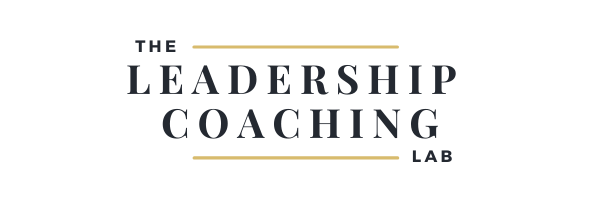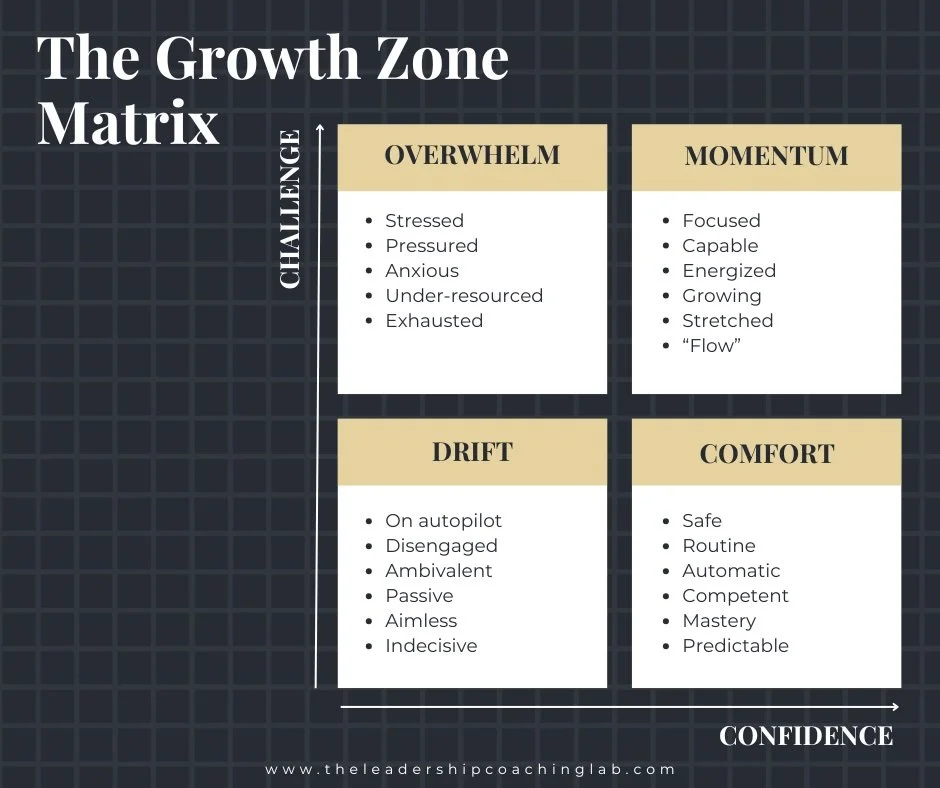Are you growing by chance or by choice? Use The Growth Zone Assessment as your starting point for intentional growth.
We cannot change what we are not aware of, and once we are aware, we cannot help but change.
—Sheryl Sandberg
The Gap Between Growing and Drifting
You know that feeling, don't you?
It's subtle at first—a quiet hum beneath the surface of your daily routine. The sense that you're spiraling instead of flowing. That your growth & development feels more like happenstance than strategy. You're changing, sure—but are you changing in the direction you actually want to go?
Maybe it shows up as being comfortable—running the same loops, executing the same routines with competence but without inspiration. You're good at what you do, but your work no longer challenges or energizes you.
Or maybe it's drifting—going through the motions while your days blur together. You're might feel apathetic and disconnected from what you want.
For many of us, it's overwhelm—the constant, exhausting feeling of treading water. You're facing challenges that feel beyond your capacity, problems you're not sure you know how to solve, and and no matter how hard you work, you never feel caught up.
These feelings aren't random—they're data. They're telling you something specific about your capacity to grow.
Yet most of us set goals and create action plans without first understanding our current conditions. The result? Strategies that don't match our reality.
The Growth Zone Assessment is your starting point for intentional development. It’s a map of your inner landscape, defined by two fundamental forces that shape your daily experience: Challenge and Confidence.
Let's break down these two forces.
Challenge: The Gap Between Here and There
Challenge isn't just about difficulty in some objective sense. It's about the perceived gap between where you are right now and where you're trying to go.
When you're facing a high-challenge situation, you feel stretched to your limit—maybe even beyond it. When challenge is low, things feel familiar, manageable, well within your wheelhouse. Forbes points out in their piece on discomfort as a compass, that stretch isn't something to avoid—it's often the very thing pointing you toward growth.
Confidence: Your Perceived Resource Inventory
Confidence is deeper than positive thinking or self-esteem slogans. According to Psychology Today, true confidence is about your perceived resources—the full inventory of what you believe you have available to meet the moment.
This includes your internal resources: your skills, knowledge, resilience, past wins, and the wisdom you've accumulated from past failures.
And it includes your external resources: your support network, financial stability, the tools at your disposal, and the environment you're operating within.
When you feel resourced—when you believe you have what you need to handle what's in front of you—your confidence runs high. When that resource inventory feels depleted or inadequate, confidence dips.
Your Inner Landscape: The Four Growth Zones
The magic (and sometimes the mayhem) happens in how these two forces interact.
Plot Challenge on one axis and Confidence on the other, and suddenly you have a map of your inner world. Four distinct territories emerge, each indicating unique barriers — and opportunities — for growth.
1. The Comfort Zone (High Confidence, Low Challenge)
You know this place well. You've mastered the terrain.
You have the skills, the resources, the roadmap, and the challenges here barely register. Mostly everything feels safe. Predictable. Automatic. Easy.
There's nothing wrong with the Comfort Zone. We all need seasons of comfort, of operating from our strengths, of feeling competent and in control.
But here's the catch: stay too long and that safety calcifies into stagnation. The loop gets smaller. The fear of venturing out gets louder. You start to wonder, Is this all there is?
Signs you might be in this zone:
Your work feels easy, routine, or even automatic.
You feel competent and in control, but also bored or uninspired.
You aren't actively learning new skills or solving new problems.
2. The Drift Zone (Low Confidence, Low Challenge)
Here you find yourself on autopilot, in a quiet holding pattern.
With challenges low, nothing is pulling you forward, and with confidence low, you may not feel the push to seek a new path. This can lead to feelings of ambivalence or disengagement, like you're operating on autopilot.
It's not a state of stress, but rather one of stillness. You may feel that your potential is dormant, waiting for the right conditions to emerge.
Signs you might be in this zone:
You feel ambivalent or are operating on autopilot.
You lack a clear answer when thinking about "what's next?"
You feel your potential is untapped, but you're not sure how to access it.
3. The Overwhelm Zone (Low Confidence, High Challenge)
Welcome to the pressure cooker. The demands are high—maybe relentlessly so—but you feel under-resourced to meet them.
This imbalance creates the perfect storm: stress, anxiety, exhaustion, and eventually burnout. Your to-do list becomes a source of dread. You're constantly behind, constantly bracing for the next shoe to drop, constantly running on fumes.
When you're in the Overwhelm Zone, the challenge may be within your technical abilities to navigate it, but you're experiencing it as impossible because you lack confidence in your resources.
Signs you might be in this zone:
You constantly feel behind, anxious, or like you're treading water.
You're exhausted and feel like you are constantly running on fumes.
You frequently doubt your ability to handle your responsibilities.
4. The Momentum Zone (High Confidence, High Challenge)
This is the sweet spot. The place where growth isn't just happening—it's exhilarating.
Csikszentmihalyi's decades of flow research identified this state as not only the most fulfilling but also where we perform at our peak and experience the fastest skill development. It's the zone where challenge and capability are perfectly matched.
The challenges are significant (you're definitely being stretched), but your confidence is equally strong. You believe in your resources. You trust your capacity. As Unabridged Leadership explains, this is where real transformation happens—not in the absence of challenge, but in the presence of challenge paired with belief in yourself.
Signs you might be in this zone:
You feel energized, focused, and absorbed in your work.
You feel a strong sense of progress and capability, even when things are difficult.
You are productively stretched but not stressed.
The Foundations of the Growth Zone Assessment
The idea that challenge and support (or confidence) shape our growth isn't new—it's grounded in decades of research across psychology, education, and organizational development.
Back in 1966, psychologist Nevitt Sanford introduced his Theory of Challenge and Support, proposing that "for growth to occur, a person needs a balanced amount of challenge and support as appropriate for the task." Sanford observed that environments weighted too heavily toward challenge without adequate support become toxic, promoting defensiveness and anxiety. But environments with too much support and not enough challenge lead to stagnation—people never stretch beyond what they already know.
Even earlier, developmental psychologist Lev Vygotsky introduced the concept of the Zone of Proximal Development—the space between what a learner can do independently and what they can achieve with guidance. This foundational idea established that optimal growth happens in a zone where challenge is present but not overwhelming, where support bridges the gap between current and potential capability.
Nearly a decade after Sanford, psychologist Mihaly Csikszentmihalyi published his groundbreaking work on "flow" (1975), identifying the optimal state where challenge and skill are in balance. His research showed that when challenges are high but skills (confidence) are low, people experience anxiety. When skills are high but challenges are low, they experience boredom. Flow—that state of complete absorption where time disappears—occurs when there's an optimal balance between the challenge of a task and an individual's skill level.
The Growth Zone Assessment synthesizes three foundational theories:
- Sanford's Challenge and Support (1966) — growth requires the right balance of challenge and support.
- Vygotsky's Zone of Proximal Development — optimal learning happens at the edge of capability, where challenge is present but scaffolded support makes growth possible.
- Csikszentmihalyi's Flow Theory — identifies the conditions for peak performance and fulfillment: high challenge met with high skill (confidence).
The Growth Zone Assessment adapts these theories for professional and leadership self-assessment by focusing on perceived challenge and confidence, creating a practical diagnostic tool that reveals which zone you're in—and how to navigate forward.
What This Framework Gives You (And What It Doesn't)
This framework isn’t a personality assessment and it isn't about labeling yourself. You're not "a Comfort Zone person" or "stuck in Overwhelm." These zones are temporary locations, not permanent identities.
What this framework does give you is awareness. And awareness is power.
When you can name where you are, you can make conscious choices about where you want to go. You can identify the specific levers you need to adjust—build more confidence here, seek out more challenge there—to move toward the zone where you do your best work and feel most like yourself.
Think of it as the "you are here" marker on your intentional growth journey GPS.
Find Your Growth Zone
If you’re feeling stuck or stalled, take this free five minute quiz — backed by the science of growth & change — to measure your current capacity for growth.
You'll also join 2,000+ professionals who receive The Coaching Mindset, my newsletter for practical tips to inspire intentional growth and tools to take a coach approach.




